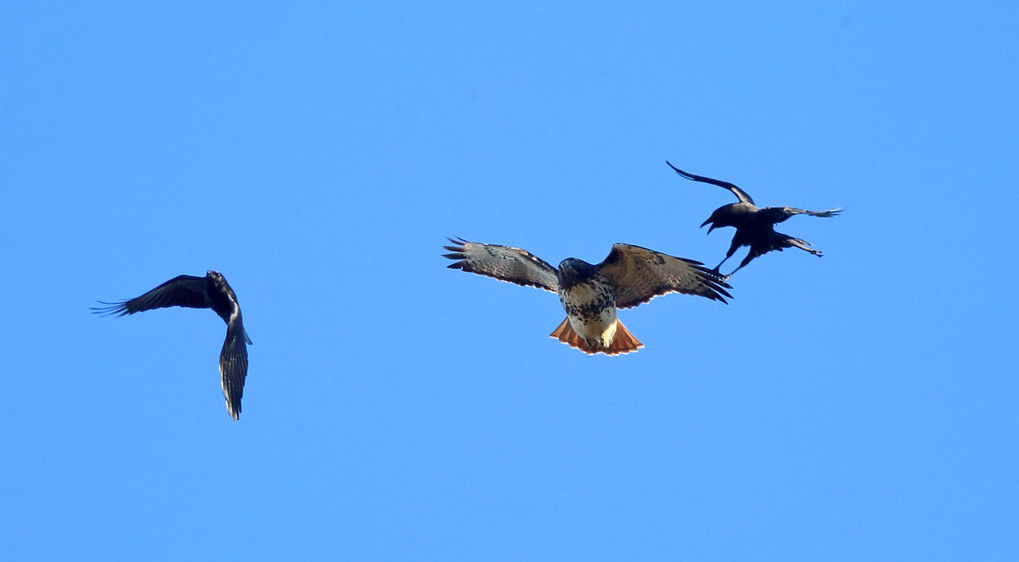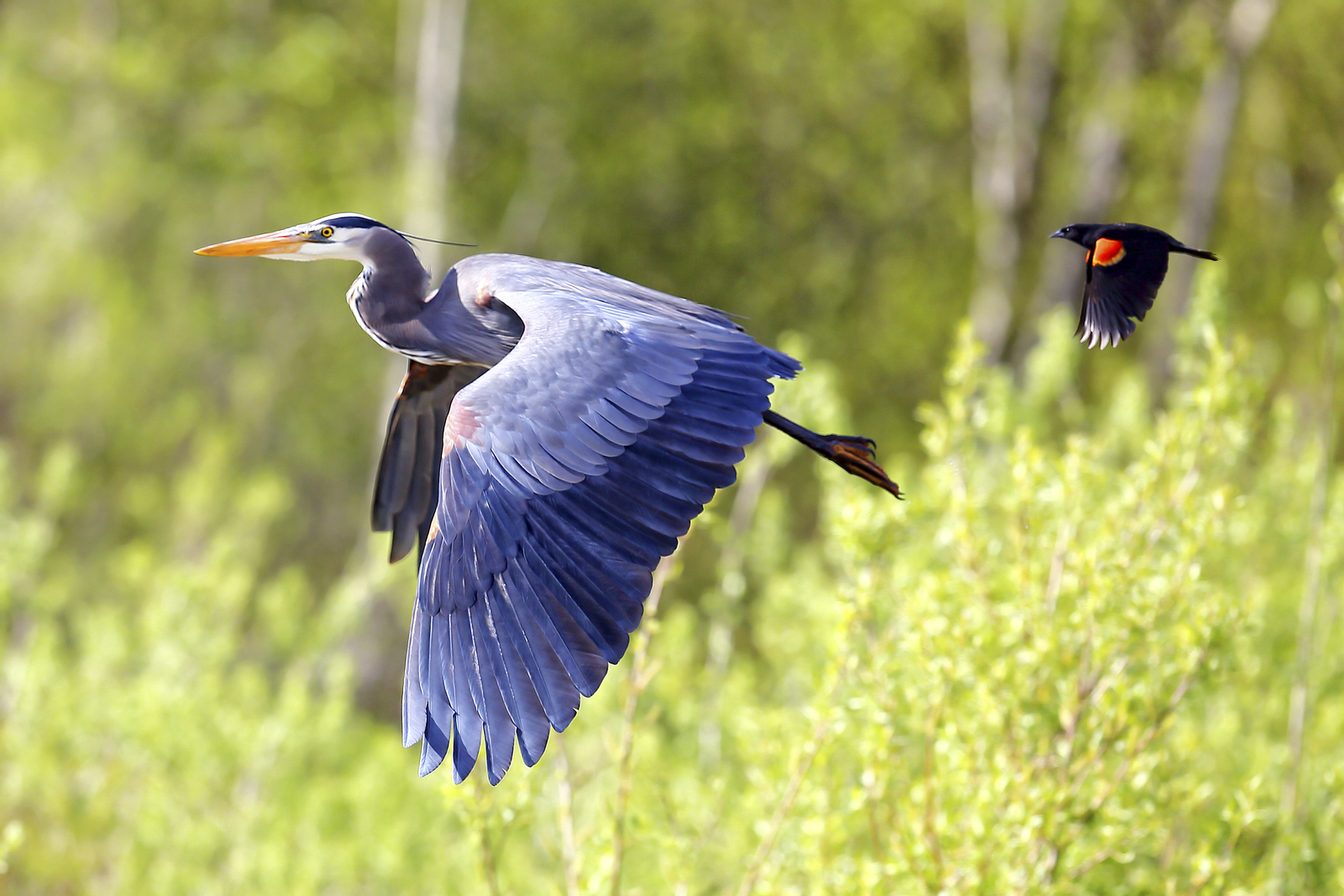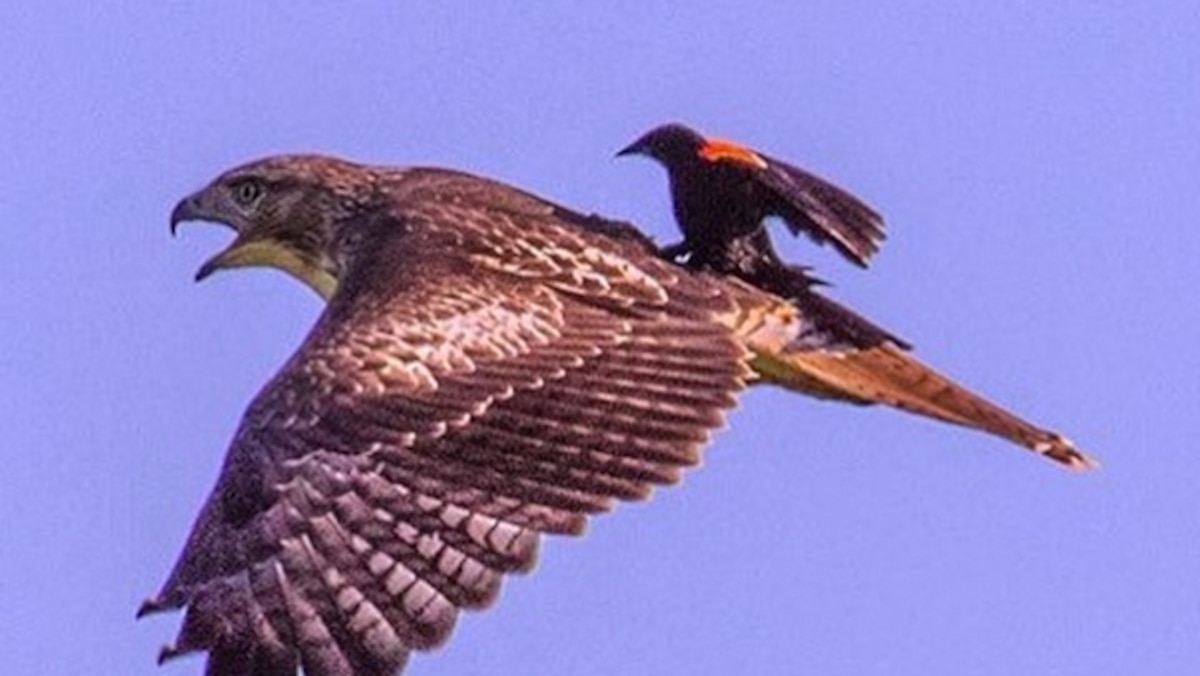Small birds often follow hawks as a survival strategy, using them as a shield against predators and scouts for potential food sources. This behavior, known as mobbing, benefits the smaller birds by alerting them to the presence of other birds or animals, allowing them to stay safe and find food more easily.
Hawks are targeted due to their large size, keen eyesight, and predatory nature, which make them excellent spotters of prey and potential threats. By staying close to hawks, small birds increase their chances of survival in the wild.
This behavior is observed in various bird species worldwide, forming a symbiotic relationship between the smaller birds and the powerful hawks.
Table of Contents

Small Birds’ Survival Strategy
Small birds have devised clever survival strategies to navigate the dangerous world of predators. One intriguing aspect of their survival strategy is their tendency to follow hawks.
While it may seem counterintuitive for a small bird to trail a predator, there are specific reasons behind this behavior.
Camouflage And Protection
In the realm of survival, camouflage can be a crucial advantage. Small birds have learned to exploit this by following hawks. By flying closely behind these formidable predators, smaller birds cleverly use them as a shield and disguise. Hawks possess sharp claws and beaks that make them formidable opponents to any would-be attackers.
So, how does this protect the smaller birds? Well, predators such as snakes, larger birds, or even other hawks may think twice before attacking a group of birds in fear of the hawk’s powerful defense mechanisms.
This tactic allows the smaller birds to blend in with their larger counterpart, creating confusion and making it difficult for predators to single them out.
Hawks have exceptional eyesight and a keen sense of awareness, detecting potential threats from a distance. Small birds understand this and exploit the hawk’s alertness to their advantage.
Eavesdropping For Alarm Calls
Small birds are masters of eavesdropping, and this skill becomes particularly valuable when following hawks. While trailing the hawk, small birds keep a keen ear out for any alarm calls made by other birds or animals.
These alarm calls serve as early warning signals that potential danger is approaching. Once the small birds hear these warning cries, they can swiftly react by seeking cover or changing their trajectory to avoid any threats.
The ability to eavesdrop on alarm calls allows the smaller birds to benefit not only from their own heightened senses but also from the collective vigilance of other creatures.
It provides them with an added layer of protection and aids in their survival strategy by keeping them one step ahead of potential predators.
In conclusion, the small birds’ survival strategy relies on their ingenious tactics of camouflage, protection, and eavesdropping. By following hawks, they benefit from the predator’s intimidating presence and sharp senses, effectively using them as camouflage and a line of defense.
Their eavesdropping skills enable them to stay alert to any imminent danger through alarm calls. Nature continues to exhibit remarkable strategies for survival, and this fascinating behavior of small birds following hawks is a testament to their adaptability and tenacity.

Benefits Of Following Hawks
Small birds follow hawks for a variety of benefits including protection from predators, easier access to food sources, and learning valuable hunting skills.
Protection From Predators
One of the top benefits of small birds following hawks is the increased protection from predators. This symbiotic relationship allows smaller birds to take advantage of the hawk’s keen eyesight and swift reactions, ultimately deterring potential threats.
Hawks are natural hunters and their mere presence can ward off birds of prey, such as falcons or owls, which may prey on the smaller species.
Access To Food Sources
Following hawks also provides small birds with an excellent opportunity to access food sources that might otherwise be out of reach.
Hawks are skilled hunters and can spot prey from high altitudes. When a hawk swoops down to catch its prey, smaller birds take advantage of the commotion and swoop in to snatch any leftovers or scare away potential competitors.
Easier Navigation
Smaller birds benefit from easier navigation when following hawks. Hawks are adept at soaring and swiftly gliding through the sky.
Types Of Small Birds That Follow Hawks
Small birds follow hawks as a survival strategy, benefiting from the predators’ keen eyesight and ability to locate prey.
Smaller birds can snatch insects and rodents startled by the larger bird’s presence. This behavior also allows them to access areas where hawks cannot reach.
Species Known To Engage In This Behavior
When it comes to understanding the behavior of small birds following hawks, it is essential to explore the different types of birds that exhibit this fascinating behavior.
While not all small bird species engage in this behavior, there are a few notable species that commonly follow hawks in the skies.
Here are some common bird names known for following hawks:
Corvids:
- Crows
- Ravens
- Jays
- Magpies
Songbirds:
- American robins
- Eastern kingbirds
- Blue jays
- Chickadees
- Mockingbirds
- Wrens
Other birds:
- Starlings
- Grackles
- Blackbirds
Reasons For Variation Among Species
The variation in behavior among different bird species that follow hawks can be attributed to a range of factors. Each species has evolved unique adaptations and preferences that shape their behavior. Here are some reasons for the variation among these fascinating small birds:
- Prey Preference: Some bird species follow hawks to take advantage of the prey flushed out by the hawk’s presence. By tailing hawks, these birds can easily snatch insects, small mammals, or other prey that might be disturbed or scared away by the hunting hawk.
- Protection From Predators: For certain small birds, flying near hawks protects them from potential predators. Hawks are known to be skilled hunters and can deter other predatory birds from approaching. By staying close to hawks, smaller birds can reduce their risk of predation.
- Navigation Assistance: In some cases, small birds follow hawks as a navigational aid. Hawks rely on their keen eyesight and can easily spot thermals and air currents. By following a hawk’s flight path, smaller birds can take advantage of these favorable wind patterns, conserving energy during long migrations or finding better foraging grounds.
- Learning From Experienced Hunters: Young birds often observe and learn from more experienced hunters, such as hawks. By tailing hawks, they can gain valuable insights into hunting techniques, foraging strategies, and locating food sources. The presence of a hawk can serve as a mentorship opportunity for young birds, hastening their development as skilled hunters.

Factors Affecting Small Birds’ Decision To Follow Hawks
Have you ever wondered why small birds sometimes choose to follow hawks? This intriguing behavior is not only fascinating to observe but also has interesting reasons behind it.
Factors such as learning from experienced birds and risk assessment with foraging opportunities play key roles in a small bird’s decision to follow hawks.
Learning From Experienced Birds
One significant factor influencing small birds to follow hawks is the opportunity to learn from experienced birds. Juvenile birds, in particular, tend to mimic the behavior of older, more knowledgeable individuals.
By tagging along with hawks, small birds can observe and imitate their hunting techniques, flight patterns, and overall survival strategies. This valuable learning experience enables small birds to increase their chances of success in finding food, avoiding predators, and navigating the skies.
Risk Assessment And Foraging Opportunity
Another factor that affects a small bird’s decision to follow hawks is the assessment of risk and the availability of foraging opportunities. Hawks are powerful predators that excel in locating and capturing prey.
Small birds can take advantage of this by following hawks and benefitting from the disturbances they create. As hawks swoop through the air pursuing their targets, they inadvertently flush out potential hidden prey
Such as insects or small animals, that reside in shrubs, grasses, or other covered areas. This presents a golden opportunity for small birds to snatch up the exposed and readily available food.
Furthermore, by trailing behind hawks, small birds can gain a level of safety. Predators typically focus on larger targets, so by associating themselves with hawks, small birds decrease their risk of being targeted by other predators.
This association creates a safety-in-numbers effect, where the presence of hawks deters potential threats, allowing small birds to focus on foraging with reduced vigilance.
Frequently Asked Questions
Do Hawks Go After Smaller Birds?
Yes, hawks do go after smaller birds. Hawks are predatory birds and their diet includes smaller birds along with rodents and other small animals. They use their sharp talons and beaks to capture and eat their prey.
How Do Birds Know When A Hawk Is Around?
Birds have excellent eyesight and keen hearing, allowing them to detect hawks nearby. They are alert to their presence, observing their flight patterns and listening for specific calls, ensuring they can react quickly and escape potential danger.
Why Are Crows Chasing A Hawk?
Crows chase hawks because they see them as a threat to their territory or food sources.
What Kind Of Hawk Eats Small Birds?
Hawks that eat small birds include the Cooper’s hawk and the sharp-shinned hawk. They are known as bird predators.
Conclusion
Small birds following hawks is an intriguing phenomenon in the avian world. This behavior, known as “kleptoparasitism,” benefits the smaller birds in various ways. By following hawks, they have the advantage of easily locating prey, and they also gain protection from potential predators.
This symbiotic relationship showcases the resourcefulness and adaptability of these feathered creatures. Understanding this unique behavior sheds light on the fascinating dynamics of nature.

I am a writer and blogger who is passionate about birds. I write to inspire and educate others about the beauty and importance of avian species in our ecosystem. I love to watch birds flying and taking their photographs to capture those memories.